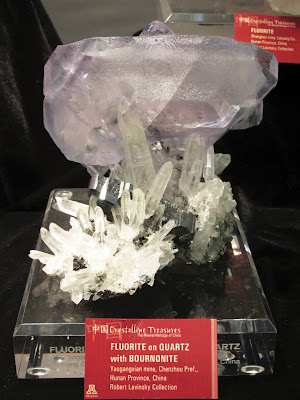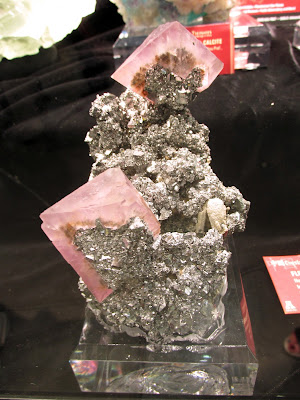Yes it's that time year of again, the Tucson Gem and Mineral Show, one of the most important events for the mineral world. Why is Tucson such a big deal? Well, there are several large mineral shows throughout the year (Denver, St Marie-aux-Mines, Munich) but Tucson is the largest. The Tucson visitor's Bureau estimates that 55,000 people will attend the 2013 show! Tucson started as a small mineral show in the 1950's and has grown into an enormous mineral-fossil-gem-meteorite extravaganza that lasts a month and takes over the Tucson Convention Center as well as hotels and parking lots throughout the city. Dealers from all over the world bring their stock and their recent discoveries to Tucson hoping to make a profit. If you can only go to one show, Tucson is it. Geologists and curators of museum collections also descend on the city hoping to find new specimens for both research and displays.
The finale event is the Tucson Gem and Mineral Society Show in the Tucson Convention Center. This is a large and well-organized show featuring both vendors and exhibits. Each year has a theme (this year was "Fluorite" next year is "Diamonds"), and museums and private collectors make displays of their best specimens to show off. While the best, most beautiful minerals in the world are rarely for sale at Tucson, they can sometimes be seen in the exhibit cases of the collectors!

Assoc. Curator Eloise Gaillou, work-study student Caroline Im and Collections manager Alyssa Morgan (3/4 of team L.A. County)
To start off the week, Eloïse and Alyssa are joined by USC work-study student Caroline Im. Caroline has worked for us for 3.5 years sorting micromounts, it's about time she came to Tucson! Tony will join us next week after the gem shows are over.
We begin at AGTA. This is a relatively high-end show (at least for Tucson).
 |
| An overview of the AGTA show at the Convention Center |
 |
| The Spanish Inquisition Necklace |
 |
| Collections Manager Russ Feather and volunteer Chris Webb |
Suite of fancy colored tanzanite. Courtesy Pala International.
We were very interested in acquiring a suite of fancy colored zoisites (a.k.a. tanzanites). These are rare colors from Arusha, and they are not heat-treated. We are still working on getting some of these, and will keep you posted.
Eloïse holding a wonderful Paraiba tourmaline from the Somewhere In The Rainbow collection.
Taking a quick break with Pierre Hardy and Stephanos Karampelas of the Gübelin Gem Lab in Switzerland. They spent part of a day patiently showing us cool stuff at the show and explaining some of the new treatments to dishonestly enhance the color of certain stones. That was very kind of them and we learned a lot!
 |
| We saw a lot of these faceted pearls, they are kind of interesting looking. Courtesy Edward Boehm. |
 |
| Close up on some beautifully textured boulder opal from Australia. |
 |
| Equatorian Imports had impressive jewelry made of red beryl from Utah and sapphires from Montana. All-American. |
We head across the parking lot to the GJX show, which is in a tent (but a very nice tent). GJX has a greater variety of gems and jewelry. More of a range from low end to very high end, but also fun oddball things like rare gems and geologically interesting stuff!
Luciana Barbosa had neat green Paraiba tourmalines with inclusions of copper metal. Later on, after mentioning this to a few Council Members, Mary & Bruce Stambaugh decided to buy this stone for us! Thanks a lot to the two of you! No picture with them unfortunately, we will have to rectify that.
So many gems to look at, so little time! It helped that we had made a list of stones to look for. Still it is very difficult to get through GJX without stopping at every booth. Even in comfortable shoes it is just painful.
One of our favorites, Coast to Coast Rare Gems. I need a faceted tugtupite from Greenland! That's cool!
Denis Gravier from Gravier & Gemmes is another dealer who has fun and interesting stones. These zoned diamonds were purchased by the Smithsonian for a collaborative research project with Eloïse.
Denis also had three tiny intriguing andradite garnets from San Benito County, California. We are new to CA and had not heard of such things so of course we called Tony. Tony had seen a few andradites from the New Idra Range (near the benitoite mines) but they were topazolites (yellow-brown andradite) and very expensive. Denis' garnets were demantoid (vivid green andradite) and cat's eyes due to asbestos inclusions. They were also very expensive but they are about to set us off on a crazy hunt we will explain in a later post.
Click below to read more about the show!

















































































